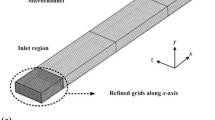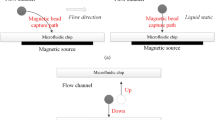Abstract
Magnetophoresis is one of the most important separation methods in biological and chemical engineering. In this paper, a novel impact parameter on separation efficiency, i.e., the angle between the vectors of magnetic force and fluid velocity, was derived from the basic equation describing the motion of magnetic beads in microchannels. It is proposed that one of the most important approaches for separation efficiency enhancement is to improve the coordination of magnetic force field and fluid flow field. A T-shaped microchannel magnetophoretic separator was designed based on the angle. And then a two-dimensional dynamic model of magnetic beads moving in microchannels was established to study the separation efficiency of T-shaped microseparator by combined use of finite element method and Runge-Kutta method. The results show that the capture efficiency of T-shaped microseparator is much higher than that of the straight microseparator at the same conditions. For small magnetic beads at high fluid velocities, the designed T-shaped microseparator could still keep high separation efficiency whereas the conventional straight microseparator fails to separate the magnetic beads. Further analysis shows that the mechanism of separation efficiency enhancement lies in the synergy of magnetic force field and flow field, which directly leads to large deflected velocity of the magnetic beads from the main stream, and thus increasing the separation efficiency. It is anticipated that the results in this paper are theoretically helpful for the optimum design of highly efficient magnetophoretic separators.
Similar content being viewed by others
Abbreviations
- B :
-
total magnetic flux density, T
- B 0 :
-
external magnetic flux density, T
- B 1 :
-
magnetic flux density generated by soft magnets, T
- d p :
-
diameter of the magnetic bead, μm
- e R :
-
relative error
- f D :
-
wall drag multiplier
- F d :
-
drag force, N
- F m :
-
magnetic force, N
- h 1 :
-
width of main channel, μm
- h 2 :
-
width of bifurcates, μm
- h 3 :
-
length of each soft magnet, μm
- H :
-
total magnetic field intensity, A m−1
- H 1 :
-
magnetic field intensity generated by soft magnets, A m−1
- L 1 :
-
length of computation domain, mm
- L 2 :
-
width of computation domain, mm
- L e :
-
width of each soft magnet, μm
- L s :
-
space between two neighboring soft magnets, μm
- M es :
-
saturated magnetization of the soft magnet, A m−1
- M ps :
-
saturated magnetization of the magnetic bead, A m−1
- P f :
-
pressure, Pa
- R p :
-
radius of the magnetic bead, μm
- R :
-
vector position of the magnetic bead, m
- s :
-
distance between the magnetic bead and the microchannel wall, m
- SE :
-
separation efficiency
- t :
-
time, s
- t 0 :
-
residential time, s
- U :
-
average fluid velocity in the microchannel, m s−1
- u f :
-
fluid velocity vector, m s−1
- u p :
-
velocity vector of the magnetic bead, m s−1
- u py :
-
y-component of the magnetic bead velocity, m s−1
- V p :
-
volume of the magnetic bead, m3
- Δy :
-
deflection, m
- η f :
-
dynamic viscosity, Pa s
- θ :
-
synergy angle
- μ 0 :
-
permeability of vacuum, N A−2
- ρ f :
-
fluid density, kg m−3
- ϕ 1 :
-
magnetic potential, A
- χ eff :
-
effective magnetic susceptibility of the magnetic bead
References
Pamme N. Magnetism and microfluidics. Lab Chip, 2006, 6: 24–38
Gijs M. Magnetic bead handling on-chip: New opportunities for analytical applications. Microfluid Nanofluid, 2004, 1(1): 22–40
Lim J K, Lanni C, Evarts E R, et al. Magnetophoresis of Nanoparticles. ACS NANO, 2011, 5(1): 217–226
Teste B, Malloggi F, Gassner A L, et al. Magnetic core shell nanoparticles trapping in a microdevice generating high magnetic gradient. Lab Chip, 2011, 11: 833–840
Bu M Q, Christensen T B, Smistrup K, et al. Characterization of a microfluidic magnetic bead separator for high-throughput applications. Sens Actuators A, 2008, 145–146: 430–436
Choi J W, Oh K W, Thomas J H, et al. An integrated microfluidic biochemical detection system for protein analysis with magnetic bead-based sampling capabilities. Lab Chip, 2002, 2: 27–30
Smistrup K, Hansen O, Bruus H, et al. Magnetic separation in microfluidic systems using microfabricated electromagnets-experiments and simulations. J Magn Magn Mater, 2005, 293(1): 597–604
Ramadan Q, Samper V, Poenar D, et al. Magnetic-based microfluidic platform for biomolecular separation. Biomed Microdevices, 2006, 8(2): 151–158
Guo S, Zuo C, Huang W, et al. Response of super-paramagnetic beads in microfluidic devices with integrated magnetic microcolumns. Microelectron Eng, 2006, 83(4–9): 1655–1659
Wang Y, Chen X, Cao H, et al. Study of a Novel Microfluidic DNA Extraction Chip. Micronanoelectron Tech, 2007, 9: 853–857
Xia N, Hunt T P, Mayers B T, et al. Combined microfluidic-micromagnetic separation of living cells in continuous flow. Biomed Microdevices, 2006, 8: 299–308
Furlani E P. Analysis of particle transport in a magnetophoretic microsystem. J Appl Phys, 2006, 99: 024912
Tarn M D, Peyman S A, Robert D, et al. The importance of particle type selection and temperature control for on-chip free-flow magnetophoresis. J Magn Magn Mater, 2009, 321: 4115–4122
Drogoff B L, Clime L, Veres T. The influence of magnetic carrier size on the performance of microfluidic integrated micro-electromagnetic traps. Microfluid Nanofluid, 2008, 5: 373–381
Chen H T, Kaminski M D, Ebner A D, et al. Theoretical analysis of a simple yet efficient portable magnetic separator design for separation of magnetic nano/micro-carriers from human blood flow. J Magn Magn Mater, 2007, 313: 127–134
Nandy K, Chaudhuri S, Ganguly R, et al. Analytical model for the magnetophoretic capture of magnetic microspheres in microfluidic devices. J Magn Magn Mater, 2008, 320: 1398–1405
Sinha A, Ganguly R, De K A, et al. Single magnetic particle dynamics in a microchannel. Phys Fluids, 2007, 19(117102): 1–5
Lee Y F, Lien K Y, Lei H Y, et al. An integrated microfluidic system for rapid diagnosis of dengue virus infection. Biosens Bioelectronics, 2009, 25(4): 745–752
Suzuki H, Ho C, Kasagi N. A chaotic mixer for magnetic bead-based micro cell sorter. J Microelectromech Syst, 2004, 13(5): 779–790
Gijs M, Lacharme F, Lehmann U. Microfluidic applications of magnetic particles for biological analysis and catalysis. Chem Rev, 2010, 110(3): 1518–1563
Guo Z Y, Tao W Q, Shah R K. The field synergy (coordination) principle and its applications in enhancing single phase convective heat transfer. Int J Heat Mass Transfer, 2005, 48(9): 1797–180
Author information
Authors and Affiliations
Corresponding author
Rights and permissions
About this article
Cite this article
Wu, X., Wu, H. & Hu, D. High-efficiency magnetophoretic separation based on synergy of magnetic force field and flow field in microchannels. Sci. China Technol. Sci. 54, 3311–3319 (2011). https://doi.org/10.1007/s11431-011-4593-8
Received:
Accepted:
Published:
Issue Date:
DOI: https://doi.org/10.1007/s11431-011-4593-8




